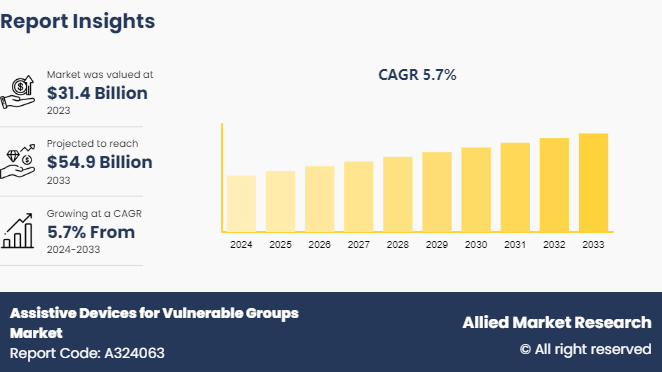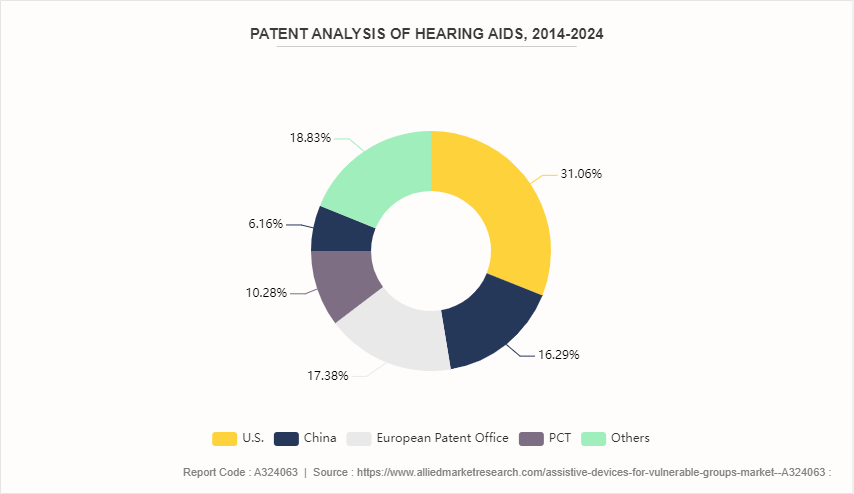Assistive Devices For Vulnerable Groups Market Research, 2033
The global assistive devices for vulnerable groups market was valued at $31.4 billion in 2023, and is projected to reach $54.9 billion by 2033, growing at a CAGR of 5.7% from 2024 to 2033. Increase in the adoption and accessibility of assistive devices for vulnerable groups is expected to drive the market growth.

Market Introduction and Definition
Assistive devices for vulnerable groups refer to tools, equipment, or technology designed to aid individuals who may have difficulties performing daily activities due to disabilities, age, or health conditions. These devices aim to enhance the quality of life, independence, and participation in various aspects of society for these groups. Vulnerable groups typically include people with disabilities with physical, sensory, cognitive, or developmental disabilities. Assistive devices for them include wheelchairs, hearing aids, and others. Further, older adults, people with chronic diseases and children living with disabilities utilize these devices.
Key Takeaways
- The assistive devices for vulnerable groups market size covers 20 countries. The research includes a segment analysis of each country in terms of value ($Billion) for the projected period 2023-2032.
- More than 1, 500 product literatures, industry releases, annual reports, and other such documents of major assistive devices for vulnerable groups industry participants along with authentic industry journals, trade associations' releases, and government websites have been reviewed for generating high-value industry insights.
- The study integrated high-quality data, professional opinions and analysis, and critical independent perspectives. The research approach is intended to provide a balanced view of global markets and to assist stakeholders in making educated decisions in order to achieve their most ambitious growth objectives.
Key Market Dynamics
The assistive devices for vulnerable groups market growth is significantly influenced by the development and adoption of assistive devices for vulnerable groups. These factors encompass technological, economic, social, and regulatory aspects, which together influence the availability, accessibility, and utilization of such devices. Technological advancements in materials science and engineering have led to the development of lighter, more durable, and more comfortable assistive devices. Integration of digital technologies such as IoT (Internet of Things) , AI (Artificial Intelligence) , and machine learning in assistive devices improves functionality and user experience. Smaller, more portable devices increase user convenience and acceptance.
Furthermore, increasing awareness and acceptance, efforts by governments, NGOs, and advocacy groups to raise awareness about the benefits of assistive devices boost the assistive devices for vulnerable groups market opportunity. The global increase in the elderly population drives demand for assistive devices that address age-related issues such as mobility, vision, and hearing impairments. Moreover, increasing incidence of chronic conditions like diabetes, arthritis, and cardiovascular diseases require long-term management. In addition, higher reported cases of disabilities due to various causes, including accidents and congenital conditions, increase the adoption of these products.
Expanding markets in developing countries increase the demand for cost-effective and locally manufactured assistive devices. Moreover, increased investment by public and private sectors in the research and development of new and improved assistive technologies further drives the market growth. Collaborations between tech companies, healthcare providers, and academic institutions to innovate and improve assistive devices boost the market assistive devices for vulnerable groups market share.
Patent Analysis of Hearing Aids, 2014-2024
Although the growth of market has been more rapid in recent years, the industry can draw on the patents filed by various companies, boosting the assistive devices for vulnerable groups market forecast. For instance, patents filed by the companies based in U.S. dominated the same with 27.6% share, Patent Cooperation Treaty (PCT) holds a share of about 9.9%, China holds a share of about 18.2%, and other countries held a share of about 21.1%.

Market Segmentation
The assistive devices for vulnerable groups market analysis is segmented into product, end-user, and region. Based on product type, the market is classified into hearing & vision aids, mobility assistive devices, bathroom safety equipment, and medical furniture.? As per end-user, the market is classified into hospitals, home care and others. Region-wise, the market is analyzed across North America, Europe, Asia-Pacific, and LAMEA.
Regional/Country Market Outlook
North America accounted for a major assistive devices for vulnerable groups market share of the assistive devices for vulnerable groups market owing to the presence of several major players, availability of advanced healthcare facilities, and high healthcare infrastructure expenditure by the government organizations in the region which drive the growth of the market.?
Asia-Pacific assistive devices for vulnerable groups market size is estimated to grow with the highest CAGR during the forecast period, owing to enhancements in healthcare facilities, increase in elderly population, and rise in healthcare expenditure. In addition, this region offers lucrative opportunities for the assistive devices for vulnerable groups market key players, owing to a rising awareness of advanced medical technologies. Companies are focusing on this region to expand their market presence.
Industry Trends
- There is a growing focus on developing cost-effective assistive devices to increase accessibility for low-income populations and developing countries.
- The integration of smart technology, such as IoT (Internet of Things) and AI (Artificial Intelligence) , into assistive devices is enhancing their functionality and user experience. Examples include smart hearing aids, voice-activated wheelchairs, and others.
Competitive Landscape
The major players operating in the assistive devices for vulnerable groups market are GN Resound Group, Starkey Hearing Technologies, Siemens AG, William Demant Holding A/S, Sonova Holding AG, AI Squared, Invacare Corporation, Drive Medical, Nordic Capital (Sunrise Medical Llc) , and Pride Mobility Products Corporation.
Recent Developments
- In February 2024, Starkely announced the new product launch of Signature Series, a brand-new line of custom hearing aids with enhancements to Genesis AI.
- In February 2023, Oticon announced the launch of New Oticon Real Hearing Aid that reduces disruptive sounds, improving clarity and comfort even in challenging environments.
Key Sources Referred
- National Center for Biotechnology Information
- World Health Organization (WHO)
- National Library of Medicine
- The United States Food and Drug Administration
- U.S. Department of Health & Human Services
- Centers for Disease Control and Prevention
- Australian Institute of Health and Welfare
- Johns Hopkins Medicine
- National Centre for Disease Control (NCDC)
Key Benefits For Stakeholders
- This report provides a quantitative analysis of the market segments, current assistive devices for vulnerable groups market trends, estimations, and dynamics of the market analysis from 2024 to 2033 to identify the prevailing market opportunities.
- The assistive devices for vulnerable groups industry market research is offered along with information related to key drivers, restraints, and opportunities.
- Porter's five forces analysis highlights the potency of buyers and suppliers to enable stakeholders make profit-oriented business decisions and strengthen their supplier-buyer network.
- In-depth analysis of the assistive devices for vulnerable groups market segmentation assists to determine the prevailing market opportunities.
- Major countries in each region are mapped according to their revenue contribution to the global market.
- Market player positioning facilitates benchmarking and provides a clear understanding of the present position of the market players.
- The report includes the analysis of the regional as well as global assistive devices for vulnerable groups industry trends, key players, market segments, application areas, and market growth strategies.
Assistive Devices for Vulnerable Groups Market , by Product Report Highlights
| Aspects | Details |
| Market Size By 2033 | USD 54.9 Billion |
| Growth Rate | CAGR of 5.7% |
| Forecast period | 2024 - 2033 |
| Report Pages | 280 |
| By Product |
|
| By End-user |
|
| By Region |
|
| Key Market Players | Nordic Capital (Sunrise Medical Llc), Sonova Holding AG, Siemens AG, Starkey Hearing Technologies, AI Squared, Drive Medical, William Demant Holding A/S, Pride Mobility Products Corporation., Invacare Corporation, GN Resound Group |
Technological advancements in materials science and engineering have led to the development of lighter, more durable, and more comfortable assistive devices are the upcoming trends of Assistive Devices for Vulnerable Groups Market in the globe
Home care is the lucrative end user of Assistive Devices for Vulnerable Groups Market
North America is the largest regional market for Assistive Devices for Vulnerable Groups Market.
The assistive devices for vulnerable groups market was valued at $31.40 billion in 2023 and is estimated to reach $54.87 billion by 2033, exhibiting a CAGR of 5.7% from 2024 to 2033.
The major players operating in the assistive devices for vulnerable groups market are GN Resound Group, Starkey Hearing Technologies, Siemens AG, William Demant Holding A/S, Sonova Holding AG, AI Squared, Invacare Corporation, Drive Medical, Nordic Capital (Sunrise Medical Llc), and Pride Mobility Products Corporation.
Loading Table Of Content...



